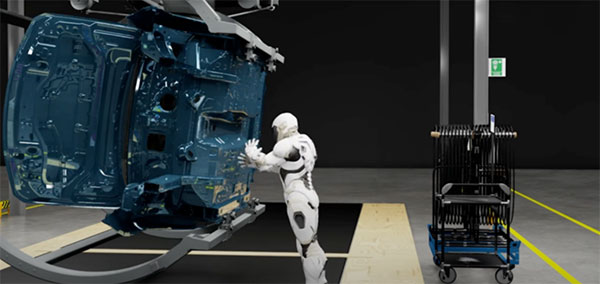Engineering Models Gain Digital Access to Space and Time
CAD and CAE companies are exploring digital twins of products, processes and environments to improve engineering outcomes.

Simulation expert Ansys collaborates with NVIDIA on various technologies that can be used inside Omniverse. Image courtesy of Ansys.
Latest News
July 26, 2023
In the madcap science fiction novel “Master of Space and Time” by Rudy Rucker, inventor Harry Gerber mangles the laws of science to create a new universe. It’s all fun and games until slugs enslave humans and the gluons run out.
If Harry Gerber had started with a digital twin, he might have prototyped his way to a safe and sane alternative universe—but it would have made for a lousy comic novel. Back in our universe, engineering models are gaining access to the digital equivalent of space and time. Recent hype has focused on social metaverses, which seem to be currently going nowhere.
The most immediately useful work is creating cyberspaces for engineering. In effect, these are digital twins that go beyond being a virtual version of an asset, but also a virtual version of processes and environments. Several CAD/CAE companies and high-profile manufacturers are supporting the effort, using technologies with origins in engineering and media.
From Static Model to Live Twin
The digital twin’s original purpose was to provide a physically accurate virtual version of an asset under design. While some were creating digital twins after making the physical version, the intention was always that the digital twin led to the physical version.
These twins made it possible to do model-based design—the practice of using simulation technology to understand the behavior of a whole asset. The process provides a mathematical and visual approach to develop not only individual parts but also complex systems.
Industry attention then moved to the next logical step, a live (or real-time) digital twin. This next step requires the model to be more than a geometrically and physically accurate depiction. Consensus has emerged on several related points that define a live digital twin:
- It is the single source of truth.
- It is a physically accurate representation.
- It is accurately synchronized to its real-world operations, actual or intended.
- It uses machine learning or other artificial intelligence (AI) technology for an autonomous feedback loop to maintain authentic behavior and representation.
Using simulation technology to analyze a model is an aspect of having a live digital twin, but it is not the full story. As with the mad inventor, space and time must be fully integrated.
Omniverse and USD: The Missing Links
GPU manufacturer NVIDIA has long been associated with advanced graphics for manufacturing as well as other fields, including gaming and media. Internal research and input from customers led the company to develop Omniverse, an open platform designed for collaborative use and exchange of 3D assets.

PTC Creo is among the most recent additions to the set of Omniverse direct connection plug-ins. The direct connection provides access to the Omniverse renderer, as well as the ability to combine a Creo model with models from other software. Image courtesy of PTC.
To drive adoption, NVIDIA selected universal scene description (USD) as a key aspect of Omniverse. USD is an open-source file format developed by Pixar Animation Studios. It is widely recognized for its flexibility, scalability and extensibility. With USD, Omniverse became an ecosystem where users share, edit and visualize assets and scenes in real time.
It didn’t take long for manufacturers, engineering teams and leading CAD/CAE software developers to realize Omniverse offers more than an environment for collaboration and exchange. Pilot projects and deployed applications are now using Omniverse to test, manipulate and iterate using real-world conditions for physics and processes.
In January 2023, NVIDIA released a major update to Omniverse Enterprise, a licensed version meant for commercial and industrial use. (There is also a free version of Omniverse for individual noncommercial use.) It supports the current and previous generations of NVIDIA GPUs. Nearly all enterprise CAD and CAE vendors now have direct compatibility with Omniverse or allow for model conversion to the USD format for use in an Omniverse 3D environment.
Physical accuracy is crucial for Omniverse industrial use cases. The models come in as USD data, and then can be used with multiple physics solutions:
Physx, is an open-source solution.
Several leading domain-specific solvers are supported, including products from Siemens, Ansys, Autodesk, and others.
NVIDIA Modules provide specific technology for such aspects as data import/export, 3D viewport and real-time simulation.
The USD Advantage
When NVIDIA announced its plan to use Pixar’s USD for model import and export, there was some skepticism in the industry. But it has turned out to be a good fit. Models converted to USD for import to Omniverse maintain precise geometric and material properties. It had already been adopted by most CAD and CAE vendors, which made it ubiquitous.
USD’s offers real-time capabilities that enable engineers to interact with and modify simulation parameters on the fly. They can adjust forces, constraints and environmental conditions in real time, allowing for rapid iterations and what-if scenarios. This interactive feedback loop enhances the simulation process, enabling engineers to explore different design options, optimize performance and identify potential issues early in the development cycle.
Once inside Omniverse, USD imported models can be managed in a collaborative fashion; Interoperability issues are solved. Different aspects of the simulation, such as structural analysis, fluid dynamics or electromagnetics, can be simulated separately and combined within the USD framework.
Real Projects
In describing Omniverse in a promotional video, NVIDIA CEO Jensen Huang says, “the world’s largest industries make physical things. But they want to build them digitally.” Several companies have gone beyond kicking the tires, and have implemented Omniverse into their workflows.
A Few Examples
BMW: The German automaker recently opened a new factory in Debrecen, Hungary, designed using Omniverse. The digital version of the electric vehicle manufacturing plant receives equipment models designed and tested in Siemens products (NX and Xcelerator). The factory simulation also uses Siemens Industrial Edge to monitor and gather industrial process data at the point of origin— thus the “Edge” in the title. Together these digital twins of part and process are conjoined inside Omniverse using USD and the NVIDIA OVX server. The result is what Siemens Digital Industries Software’s Chief Technical Officer Dirk Didascalou calls a “closed-loop digital twin with real-time performance data, ideal for running simulations and AI-accelerated processes such as autonomous factories that rely on intelligent sensors and connected devices.”

A mockup of how BMW intends to use Omniverse for factory planning, combining parts, workers and equipment. Image courtesy of NVIDIA
Mercedes-Benz: Although BMW is using Omniverse for a new factory, its in-country rival will use an Omniverse installation to redesign an existing plant for electric vehicle (EV) production. The Rastatt, Germany, plant currently manufactures the company’s A- and B-Class models and the all-electric EQA. Mercedes says the “digital first” planning project won’t disrupt current production. It foresees using the Omniverse-enabled factory planning system throughout its global network of factory sites, as it continues to convert to a higher percentage of EV production.

Predator Cycling: This U.S.-based manufacturer of custom high-end carbon fiber bicycle frames and components is using an Omniverse-based workflow for working with data from multiple sources. Rhino 3D and Autodesk Fusion 360 are used for engineering design in-house. USD conversion of data for use inside Omniverse is a key aspect of their multi-tool workflow.

More Ansys Coverage
More NVIDIA Coverage
Subscribe to our FREE magazine, FREE email newsletters or both!
Latest News
About the Author
Randall S. Newton is principal analyst at Consilia Vektor, covering engineering technology. He has been part of the computer graphics industry in a variety of roles since 1985.
Follow DE





